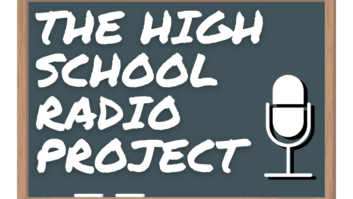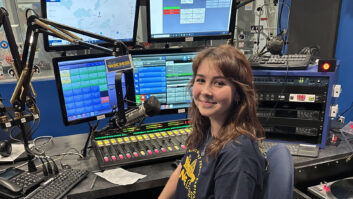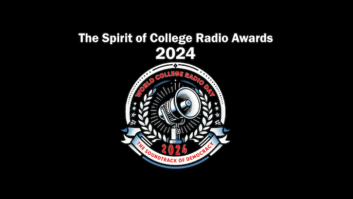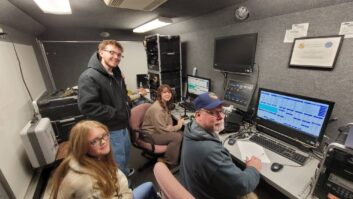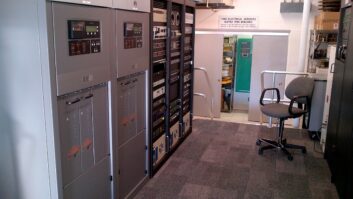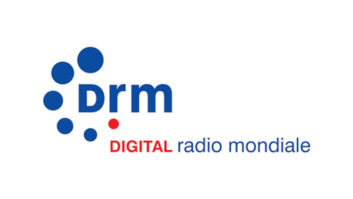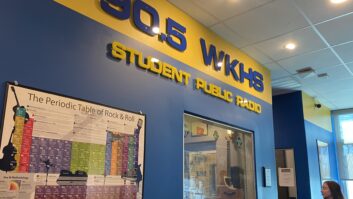
On a Wednesday afternoon last spring, a dozen high school students file into the Vacaville Christian Schools’ music room, with a trio of girls assembling in the main KVCB(LP) radio studio for a live one-hour coast-to-coast broadcast of the High School Radio Network.
Hosts Sydney Reheis, Emma Reheis and Metina Cassinelli test their equipment, ask lingering questions of their teacher Ralph Martin, and reveal that they aren’t too nervous about doing their first network show. As the program begins, they launch into a flurry of conversation and music, bantering about celebrities and popular culture, playing requested songs and fielding phone calls and text messages from friends, family and strangers. A teacher calls in, revealing that he is listening while grading papers. Further afield, a network station from Indiana messages that they are enjoying the program.
Although on a typical show, the girls are speaking largely to a local audience at their school and in Vacaville, Calif.; during a network broadcast, their voices are amplified and can be heard on high school radio stations in faraway locales, from Arizona to Indiana to Tennessee.
Every Wednesday, a different high school radio station takes the lead, sharing its broadcast with fellow High School Radio Network colleagues.
The mix of conversation and music heard during KVCB’s Feb. 7 show is fairly typical, although each station lends its personality to the mix. The fall 2019 KVCB schedule includes “VCS Sports Coverage LIVE,” “Mornings for You,” “Studio D LIVE,” “Sound Art Central” and “Time Travel Central.”
Last semester’s programs also included “The Mosh Pit” on Scratch Radio WJWS(LP) at Jasper High School in Jasper, Ind., during which the student hosts chatted about upcoming concerts, from Cher to Ty Dolla Sign, and played music from the artists.
KMIH(FM)’s General Manager Joe Bryant, who got his own start in high school radio, shared that his school broadcast from Mercer Island, Wash., this spring, and the remote was hosted by three seniors and also included “an extended sports segment from our sports talkers,” as well as music from a local band fronted by a station alum.
FROM HIGH SCHOOL RADIO DAY TO RADIO NETWORK
With live shows launching in September 2016, The High School Radio Network is now in its third year. Ralph Martin of KVCB (aka “VCS Radio”) is the mastermind behind the project, which stemmed from his initial desire to connect with others in the radio community. After reaching out to High School Radio Day founder Pete Bowers, he was off and running.
The longtime general manager of high school radio station WBFH(FM) in Bloomfield Hills, Mich. — he retired last year — Bowers started High School Radio Day in 2012 as a celebration of high school radio, and it’s been held annually since. Bowers estimates that there are approximately 200 high school radio stations in the United States, with about 80 taking part in High School Radio Day 2017.

Although High School Radio Day initially was a way to call attention to the often-overlooked high school radio scene, its impact has exceeded expectations. The website serves as a resource and meeting place for high school radio, and it helped to spawn a Facebook group for advisors, a mailing list for high school radio stations and a high school radio app to facilitate listening to these stations. The High School Radio Network is a logical extension of these efforts.
After making contact with High School Radio Day participants, Martin proposed the idea of having stations take turns going live and sharing programming every week. Upon receiving enthusiastic responses, he set up a website and a plan for weekly hour-long broadcasts occurring every Wednesday at 6 p.m. (ET).
Stations in the new “network” would agree to broadcast the program (no matter where it originated) every week. During the show, participants omit their own station IDs, instead announcing, “High School Radio Across America.”
Nearly two years into the project, there are around eight radio stations regularly producing live programming for the Wednesday broadcasts, which are being picked up by more than 20 radio stations. At this writing the fall 2018 program schedule was to posted soon on the network’s website, www.hsradionetwork.com.
Bowers remarked, “It’s cool to think that the show you are airing on your station is being broadcast on other stations around the country.”
The students at VCS Radio seem to agree. Ninth grader Metina Cassinelli acknowledged the appeal of being part of a broader high school radio community. Having listened to shows done by other schools, she pointed out, “It gives me a sense of unity knowing that we are all just a bunch of kids sitting in front of a microphone.”
Additionally, high school radio is providing a unique experience to its participants.
Bryant said, “What we teach in high school radio is storytelling, interpersonal relations and confidence … The skills my students get by putting down the cell phone, Snapchat, text messages etc., and having actual conversations with each other carry over to how well they do presentations in other classes and eventually in college and in a variety of careers.”
While commercial radio faces its challenges, Bryant said, “the need for people to entertain with stories and disseminate information has been around since cave drawings and always will be.”

In the words of VCS Radio participant Sydney Reheis, “High school radio is very fun. When a teacher or fellow student tells me they heard me on the radio, it brings a smile on my face.”
The creative aspects to radio aren’t lost on students either. Cassinelli points out, “We are kids; we have homework and sports, but being able to be on the radio for just an hour is a very freeing experience. It’s a time to be yourself and have fun. This is our escape, and I encourage other people with any interest at all, to join.”
EXPANDING PROGRAMMING — AND GOALS
For High School Radio Day 2018, there was also a network twist: It was celebrated for an entire week, from April 21 to April 28, with some stations doing live shows together or sharing promotional spots.
In keeping with that concept, High School Radio Network sharing isn’t necessarily limited to the Wednesday show and some stations have offered up additional programming that can be aired by affiliate stations at any time, including live music performances, public affairs talk shows, and extended Wednesday broadcasts.
Although Martin’s original motivation for starting a radio station was linked to his desire for students to talk about music, the project has clearly grown into a much larger program with broader goals. On a practical level, Martin said that his students learn about teamwork as well as about audio production.
Martin now has a greater appreciation for the importance of high school radio. He added, “I love high school radio, and I like what has been happening here, and I hope that that same energy is felt all over.”
Bowers has been at it even longer, sharing that, “In the 41 years I managed a high school radio station, my students never ceased to amaze me [with] how entertaining they could be. A case could be made that what you hear on high school radio is unique compared to college radio, commercial radio and satellite radio.
“The challenge we share with college, commercial and satellite radio is getting people to listen to our content. In my heart I know, if people were to tune into high school radio, they would like what they hear and would probably listen to it more.”
Jennifer Waits is a co-founder of Radio Survivor and a research associate on the Library of Congress’ Radio Preservation Task Force. She obsessively tours radio stations, which she chronicles on her blog Spinning Indie. A college radio DJ since the 1980s, she’s been at four stations and has hosted a music show at KFJC(FM) since 1999.
